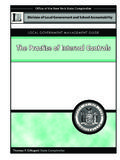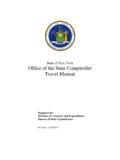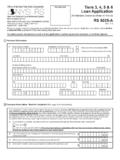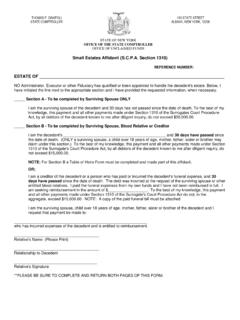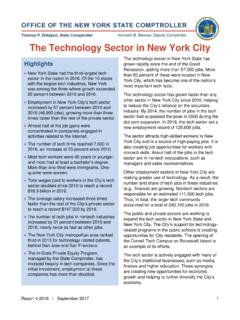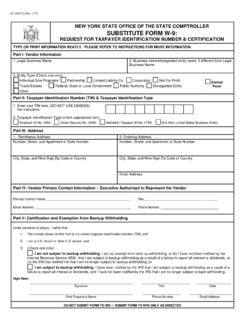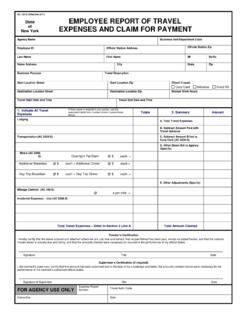Transcription of Office of the New York State Comptroller
1 Division of Local Government and School AccountabilityOffice of the New york State ComptrollerAccounting and Reporting ManualThomas P. DiNapoli State ComptrollerTable of ContentsChapter 1 Introduction ..1 Chapter 2 Funds ..2 Chapter 3 Classification and Coding Structure ..6 Chapter 4 5 Financial Reporting ..19 Chapter 6 Single-Entry Cash: Fire Districts ..21 Chapter 7 Double-Entry Modified Accrual: Fire Districts ..30 Chapter 8 Sample Journal 9 Account Code Definitions ..56 Contacts ..77 Fire Districts in New york StateFire districts are district corporations and political subdivisions of the State , distinct from the municipalities in which they are located. In general, fire districts are governed by an elected board of fire commissioners and are required to have a treasurer and secretary. The districts have the power to require the levy of taxes on real property and to borrow in their own districts should not be confused with fire companies, fire departments or fire protection districts.
2 The fire company or companies within the district are usually volunteer fire companies incorporated under the provisions of the Not-for-Profit Corporation Law and constitute the fire department of the fire district which is headed by a chief. The fire district commissioners are authorized to adopt rules and regulations governing all fire companies and departments. Fire protection districts, on the other hand, comprise a geographical area of a town which is provided fire protection pursuant to a ManualThe responsibility for oversight of fire districts by the State Comptroller is contained in the State Constitution, Article 3 of the General Municipal Law and the Town Law. Among other things, the State Comptroller s responsibilities include: performing audits, prescribing information to be included in annual financial reports and prescribing a uniform system of accounts for fire district accounting and Office of the State Comptroller (OSC) has compiled this manual as a comprehensive accounting and reporting guide for fire district officials and others interested in accounting and financial reporting by fire districts in New york State .
3 The manual provides an overview of accounting and financial reporting principles to be used by fire districts to account for and report their financial districts with $500,000 or more of revenues (excluding borrowings) are required to maintain their accounting records and report their financial activities on a double-entry modified accrual basis of accounting, and account for current assets, current liabilities and fund balances of the district. Revenues will be recognized in the accounting period in which they are available and measurable, and expenditures will generally be recognized in the accounting period in which the liability is actually incurred (See Chapter 6). Fire districts with less than $500,000 of revenues (excluding borrowings) may continue to maintain their accounting records and report their financial activities to OSC on a single-entry cash basis of accounting but will be required to report cash and fund balances for each of the districts operating funds (See Chapter 5).
4 For additional information regarding fire districts, visit the State Comptroller s website at 11 IntroductionFundsThe Uniform System of Accounts for Fire Districts is prescribed for all fire districts in New york State . The System of Accounts provides for a standard chart of accounts and fund structure. This accounting system is intended to serve many purposes. Primarily, it should furnish fire district officials with an effective aid in financial management. It should also serve the taxpayers by providing a structure for comprehensive records of fire district operations and it should provide information for program planning and statistical District FundsIn government, moneys generated for specific purposes generally must be segregated in the accounting records and used only for those specific purposes. To help demonstrate that such moneys are used for the intended purposes, fire districts and all other local governments are required to use the fund accounting concepts specified in Generally Accepted Accounting fund is a fiscal and accounting entity with a self-balancing set of accounts recording cash and other financial resources, together with all related liabilities and fund balances, and charges therein, which are segregated for the purpose of carrying on specific activities or attaining certain objectives in accordance with special regulations, restrictions or funds available for use by fire districts are.
5 Chapter 2 CodeFundsAGeneralHCapital ProjectsRReserve (cash basis only)VDebt ServiceTAAgencyTEPrivate-Purpose TrustFire districts should establish and maintain only the minimum number of funds consistent with legal and operating Fund (A)The General Fund is the major operating fund of a fire district and includes all revenues and expenditures not accounted for and reported in another are classified by are classified to separately show the amounts expended for personal services, capital outlay, contractual, debt service and other expenditures, and other special items for which a separate classification is Accounting and Reporting Manual for Fire DistrictsCapital Projects Fund (H)The Capital Projects Fund is used to account for and report financial resources that are restricted, or assigned to expenditures for capital outlays, including the acquisition or construction of capital facilities and other capital assets.
6 Separate accounting records must be maintained for each capital project and should contain sufficient information to track and report the project s complete financial history ( resources received and expended).The use of separate accounting records helps to ensure that debt proceeds related to capital expenditures are used for their intended purpose. Section of the Local Finance Law requires that proceeds of these types of obligations be deposited in a separate bank account, and expended only for the object or purpose for which issued. This fund must also be used to account for construction projects financed, in whole or in part, from General Fund or Reserve Fund and interest payments on capital borrowings are paid from appropriations from the General Fund and not from the Capital Projects Fund, except when bond anticipation notes are redeemed from the proceeds of bonds.
7 Interest on bond anticipation notes may be charged to the capital project if the board of commissioners authorizes it by Funds (R, A)In general, reserves are designed to segregate resources to provide for future contingencies and plan for major capital outlays, thereby reducing the need to rely on borrowing or outlays of current funds to finance such following reserve funds are established in accordance with General Municipal Law provisions: Repair Reserve (Section 6-d), Contingency and Tax Stabilization Reserve (Section 6-e), Capital Reserve (Section 6-g), Reserve for Payment on Bonded Indebtedness (Section 6-h), Mandatory Reserve (Section 6-l), insurance Reserve (Section 6-n), Workers Compensation Reserve (Section 6-j), unemployment insurance Reserve (Section 6-m), Employee Benefit Accrued Liability Reserve (Section 6-p) and Retirement Contribution Reserve (Section 6-r).
8 For detailed information regarding these reserves, refer to our Local Government Management Guide entitled Reserve using the single-entry cash basis of accounting, a separate fund account must be maintained for each reserve (R). For the double-entry modified accrual basis of accounting, legally established reserves are accounted for in the General Fund (A).Expenditures may be made only for the purpose for which the reserve was established. The limitation on expenditures in Section 176(18) of the Town Law does not apply to transfers to, or expenditures from most but not all, of these principal sources of revenue for these funds are budgetary appropriations. For districts using the cash-basis of accounting to comply with the law, the amount appropriated should be transferred from the General Fund to the Reserve interest or earnings on deposits and investments of reserve moneys is credited to the reserve Service Fund (V)The Debt Service Fund is provided to account for and report financial resources that are restricted or assigned to expenditures for the payment of principal and interest on long-term debt.
9 Financial resources that are being accumulated for principal and interest maturing in future years also should be reported in this fund. Debt Service Funds are not required unless segregation of resources is legally mandated. Resources legally required to be segregated include: Proceeds from sales of property on which debt is outstanding. State and Federal aid received for a project on which debt is outstanding. Interest earned on investment of proceeds of long-term debt which were not budgeted as a source of financing for the project. Unexpended proceeds of long-term levied for debt service may be credited directly to this fund or transferred from other funds. Proceeds from the sale of advance refunding bonds and the subsequent payment to the trustee bank must be recorded in this single Debt Service Fund must be maintained; however, subsidiary records must be maintained for individual debt Accounting and Reporting Manual for Fire Districts5 FundsPermanent Fund (PN)A Permanent Fund is used to account for resources that are legally restricted to the extent that only earnings, not principal, may be used for purposes that benefit the local Funds (TA, TE)Fiduciary Funds are provided to account for moneys received by the fire district treasurer which must be held for purposes other than operation of the fire district or which must be paid to other governments or are two Fiduciary Funds.
10 The prefix TA is used to identify Agency Funds and the prefix TE is used to identify Private-Purpose Trust Funds (TA) account for assets held by the fire district as an agent for individuals, private organizations or other governments and/or other funds. Agency funds are custodial in nature, and do not involve measuring the results of operations. There is no operating statement, only a balance Trust Funds (TE) account for all other trust arrangements under which principal and income benefit individuals, private organizations or other governments. Transactions of TE funds are accounted for on an accrual Assets and Long-Term Liabilities (K, W)Non-Current Governmental Assets (K) Accounts established to account for capital Governmental Liabilities (W) Accounts established to account for the unmatured general long-term debt and liabilities which are not recorded as liabilities in another 3 FundAlpha CodeGeneralACapital ProjectsHReserve - cash basis onlyRDebt ServiceVPermanentPNAgencyTAPrivate-Purpo se TrustTE6 Accounting and Reporting Manual for Fire DistrictsClassification and Coding StructureFire districts in New york State are required to use a standard system for classifying and coding accounting :A classification of accounts is a systematic arrangement of accounts based upon a definite scheme.
